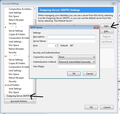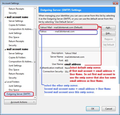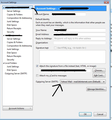
educational gmail account stopped working after switch to OAuth2
Hi,
I've really gotten hit hard by this OAuth2 thing. I have around 20 different email addresses in Thunderbird, most of which are gmail accounts (everyone I have to make an account with gets a new gmail account so that I know who sells my info but also so that if there's a compromise, then I don't lose a lot). One of them is one that got forced on me by my university and unfortunately, I must use it. So the way this account works is that when I want to log in via the web, I first am presented with a normal gmail login screen, and then I type in the full email address as the username. Next it shoves me over to my school's login screen, after which I will see the usual gmail screen provided I logged in successfully.
In Thunderbird, it *was* working normally with normal passwords (and imap is definitely enabled) but when my other gmail account(s) started failing (they have not all failed) and requiring me to switch to OAuth2, some problems arose. I'm using the same outgoing smtp server for them all (since I can't duplicate the server with different settings per account), and it demanded a switch to OAuth2 on my main account. (by "demand" I mean I got stuck in an infinite loop of it asking me for my password that worked fine before, and then I came here and discovered I needed to switch to OAuth2) So I switched several of my accounts to OAuth2, including my school account. When I did this, my school's account actually worked fine and I was really impressed (both login windows showed up in Thunderbird). But there was one misconfiguration that really bugged me that I've had for a long time so I thought I would go in and fix it. It had a reply-to in it that I didn't want. So I took that out. Clicked OK. And then the account didn't work anymore. By "not work" I mean I see no folder structure or anything. It has a little lock symbol on it. I thought "Oh crap, maybe I need to set it back to normal password." Nope. I deleted the account and created a new one. Same problem. I set the outgoing smtp server to normal password so that I could maybe try to put the school account fully on a normal password but not only would it still not log in to the imap server but the smtp server kept getting stuck in the loop that I got stuck in before that caused me to switch to OAuth2 in the first place.
Help! I don't know what to do. I don't even know what is wrong. I'm guessing wildly that I should not have changed my school account to OAuth2 and that maybe it really does still want normal passwords but since I had changed it once before, Thunderbird may have something saved that's screwing me up. But obviously I have no clue.
Servers being used: smtp.gmail.com imap.gmail.com
Life with multiple gmail accounts used to be so easy. :-(
Solución elegida
The reason you had to use the 'Reply-to' is because you were not sending out using the correct work smtp in the first place. As I said, gmail will accept the FROM address in the FROM header, but you were not actually sending anything via that work email address because it was using the default email address and it's default password, which was entirely different from the FROM email address. All recipients will see the default gmail address, so there is no point having various email addresses if anything you send out will always show the one default address for replies. Hence why you should create it's own outgoing server and not use one associated with a entirely different email address.
With OAuth2, recently made available in Thunderbird for gmail imap mail accounts. The normal password is entered, but it is changed (by gmail) to a special password for use with OAuth2.
Before going down the route of nuking the lot and starting over: As it is an imap mail account, all emails are stored on the server. So, you can delete the acount via 'Account Settings' window. Tools > Account Settings select the work imap account click on 'Account actions' Seelct : 'Remove account' Click on 'OK'
close and restart Thunderbird.
Then create work account again. File > New > Existing mail account.
Enter name, full email address and password (the one you use to access the account via webmail) click on 'Continue' button. thunderbird will check configuration settings. Make sure it has selected imap. click on 'Done' to create the mail account.
As it is using OAuth2, gmail will ask for confirmation which you need to accept before it will work.
Please report back on results.
Leer esta respuesta en su contexto 👍 0Todas las respuestas (7)
Gmail realy needs a separate smtp server setting for each incoming account. Otherwise you get an incorrect "From:" and this will probably defeat your byzantine scheme for knowing who sold your data.
Padlocks simply denote accounts that used encrypted connections (SSL or TLS) to protect your login data. All gmail (and hotmail, outlook.com, aol, gmx etc) accounts use these as standard.
My own "school" gmail account (actually a work account) uses regular SSL/TLS and I'm not keen to try it OAuth2. Unfortunately, this is a feature that was possible with older accounts; I believe newer gmail accounts oblige you to use OAuth2.
Zenos said
Gmail realy needs a separate smtp server setting for each incoming account. Otherwise you get an incorrect "From:" and this will probably defeat your byzantine scheme for knowing who sold your data. Padlocks simply denote accounts that used encrypted connections (SSL or TLS) to protect your login data. All gmail (and hotmail, outlook.com, aol, gmx etc) accounts use these as standard. My own "school" gmail account (actually a work account) uses regular SSL/TLS and I'm not keen to try it OAuth2. Unfortunately, this is a feature that was possible with older accounts; I believe newer gmail accounts oblige you to use OAuth2.
It has been working quite well for years and the headers have always been correct. This was why I liked Thunderbird.
But as of now, I'm still unable to access my school account, and this is a real problem.
re :* I'm using the same outgoing smtp server for them all (since I can't duplicate the server with different settings per account),
Each gmail account must use its own smtp outgoing server. Why do you say 'I can't duplicate the server with different settings per account'? what is the problem ? Note: the email address will be different, so the username is different so the password/OAth2 is different.
re :It has been working quite well for years and the headers have always been correct. If you have been using one smtp server then it was accepting the other gmail email addresses but it was sending via only the one.
If you have gmail IMAP mail accounts, then they should be set to use 'OAuth2'. Each gmail account should use it's own smtp server.
Are all your gmail accounts IMAP?
Before you go any further..... Please confirm
- All imap gmail accounts have been set to use OAuth2 authentication.
- You have created new smtp outgoing servers and applied each one to the correct mail account.
images show: How to add an smtp server. the 'Description' entry is for your own use to help identify which smtp is used by which email address. Use the 'Description' entry to say eg: main account, personal, business, etc, so that when you are applying that smtp to an account - see third image, you know which is which.
Modificadas por Toad-Hall el
The gmail accounts all use the same outgoing server. Of this I am quite certain. It has always worked fine (despite what you may expect, lol) but also keep in mind that I rarely use these accounts to *send* mail. In fact there's a good chance some of them have never sent any mail. I'm too lazy to check. They are just there to collect mail. Some of them get heavily spammed (stores that require email addresses as account names or in order to get discounts), some only get account-specific mail from the companies I created them for (Blizzard is a great example here).
I do have several servers stored and available for use but I know all the gmail ones have been using the same one.
They are all imap. I haven't used anything else since the early 2000s.
They are not all on OAuth2. Some of them are and some aren't. I know I switched a couple myself but I don't remember switching some of the others that are on OAuth2 so I'm not sure what happened there. They all work despite this mix. I had never heard of OAuth2 before until very recently. My gmail accounts all date back to very early times and they didn't use OAuth2. I think the last one I created was for iTunes so we might be going back to around 2007 or so. (off topic: seriously, don't people create new gmail or hotmail accounts whenever they need to use an email address to create an account with a business? Why would they want the same username across everything?)
The only account that is giving me trouble is the one that isn't able to log into the imap server anymore, and this is regardless of the smtp server.
Most of these accounts were set up years ago. I don't recall being able to enter the same server twice, but with different settings, back then. I seem to recall it giving me an error. In fact, I was one of the many people who begged for the ability to even have more than one server at all. I even created a ticket for it, although I can't remember what name I may have posted under way back then. You used to only be able to have one server! So that's why most of them share the same outgoing server because it took a while for that feature request to get implemented. They were set up years ago and, well, they worked, so they got left alone. It's possible that those ones do end up with messed up headers. I honestly can't be sure since they are not used to send mail. However, the school one, due to its age, did use this scheme, and it DID have this problem, so it had a reply-to to fix it, which is what I wanted to change most recently.
I believe the problem is that there's something stored locally that's causing an issue. I bet if I installed Thunderbird on a different profile, it would suddenly allow me to set up my school account again. Basically, I think my profile is screwed up. It dates back to the very first release of Thunderbird (has migrated to several computers by now) so it probably has a lot of crap in it. Maybe it's time to finally just start over and recreate everything, especially now that I know that I CAN set up multiple instances of the same server but with different settings. The entropy has probably gotten really bad. My mail archives are stupidly big, too. Would be nice to just nuke them. So this begs the question of how to make sure I have completely uninstalled everything on a Mac, if I choose to go this route.
Many people get by with only one email account. Many even share it with their partner or spouse.
Few create a unique address for each correspondent. It's too much hassle.
Solución elegida
The reason you had to use the 'Reply-to' is because you were not sending out using the correct work smtp in the first place. As I said, gmail will accept the FROM address in the FROM header, but you were not actually sending anything via that work email address because it was using the default email address and it's default password, which was entirely different from the FROM email address. All recipients will see the default gmail address, so there is no point having various email addresses if anything you send out will always show the one default address for replies. Hence why you should create it's own outgoing server and not use one associated with a entirely different email address.
With OAuth2, recently made available in Thunderbird for gmail imap mail accounts. The normal password is entered, but it is changed (by gmail) to a special password for use with OAuth2.
Before going down the route of nuking the lot and starting over: As it is an imap mail account, all emails are stored on the server. So, you can delete the acount via 'Account Settings' window. Tools > Account Settings select the work imap account click on 'Account actions' Seelct : 'Remove account' Click on 'OK'
close and restart Thunderbird.
Then create work account again. File > New > Existing mail account.
Enter name, full email address and password (the one you use to access the account via webmail) click on 'Continue' button. thunderbird will check configuration settings. Make sure it has selected imap. click on 'Done' to create the mail account.
As it is using OAuth2, gmail will ask for confirmation which you need to accept before it will work.
Please report back on results.
I must have deleted the part where I said I recreated the account in Thunderbird multiple times. That's frustrating because now you're wanting me to do that. I have fully removed the account from Thunderbird and added it back multiple times, to no avail. It never successfully logs into the imap server.
There is too much in this post. The basic problem is that I have an account that no longer logs into its imap server. The end. Ignore all the rest, especially the smtp stuff. I'm certain there's a profile issue.
If I can mark this as solved to make it go away, I will. Or if someone else can do it, please do.



